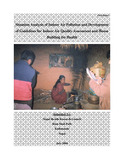Please use this identifier to cite or link to this item:
https://hdl.handle.net/20.500.14356/379| Title: | Situation analysis of indoor air pollution and development of guidelines for indoor air quality assessment and house building for health |
| Authors: | Nepal Health Research Council (NHRC) |
| Issue Date: | 2004 |
| Publisher: | Nepal Health Research Council |
| Keywords: | Indoor Air Pollution |
| Abstract: | Executive Summary: Indoor air pollution in developing world from bio-mass smoke is considered to be a significant source of public health hazard, particularly to the poor and vulnerable women and children. About 50 % of the world’s population is estimated to use solid bio-fuels like animal dung, crop residues, wood and coal for cooking daily meals and heating homes and exposure from bio-mass smoke is estimated to cause a global death toll of 2.5 million every year equivalent to 4 to 5 % of total global deaths. In fact, the emerging data from recent studies indicate that risk-wise, it ranks only below malnutrition and poor quality of water/sanitation. In Nepal, epidemiological studies as such is lacking at the moment. However, census 2001 report shows that 80 % of households depend upon solid bio-fuels for domestic uses. The total death from pneumonia alone is reported to be 4429 during the last 12 months preceding 2001 census (4.14 % of the total deaths). Similarly, the total deaths from asthma / bronchitis are reported to be 7170 (6.71%). According to Nepal Demography and Health survey, 2001, the prevalence of ARI for children below 5 years old is found to be 23 %. The below 5 years population is 12.1 % of the total population. |
| URI: | http://103.69.126.140:8080/handle/20.500.14356/379 |
| Appears in Collections: | NHRC Research Report |
Files in This Item:
| File | Description | Size | Format | |
|---|---|---|---|---|
| 444.pdf | Full Report. Download | 1.97 MB | Adobe PDF |  View/Open |
Items in DSpace are protected by copyright, with all rights reserved, unless otherwise indicated.
